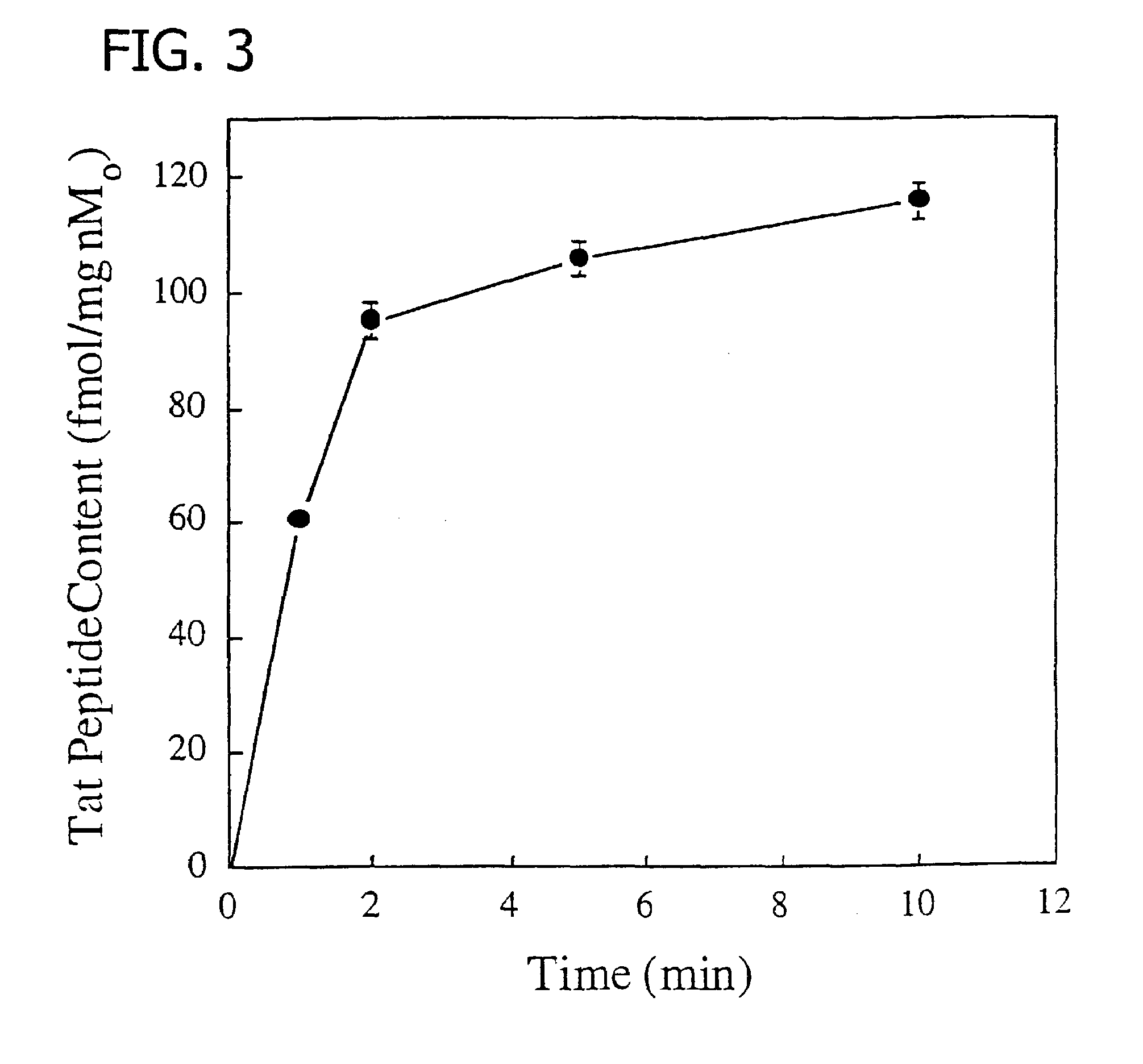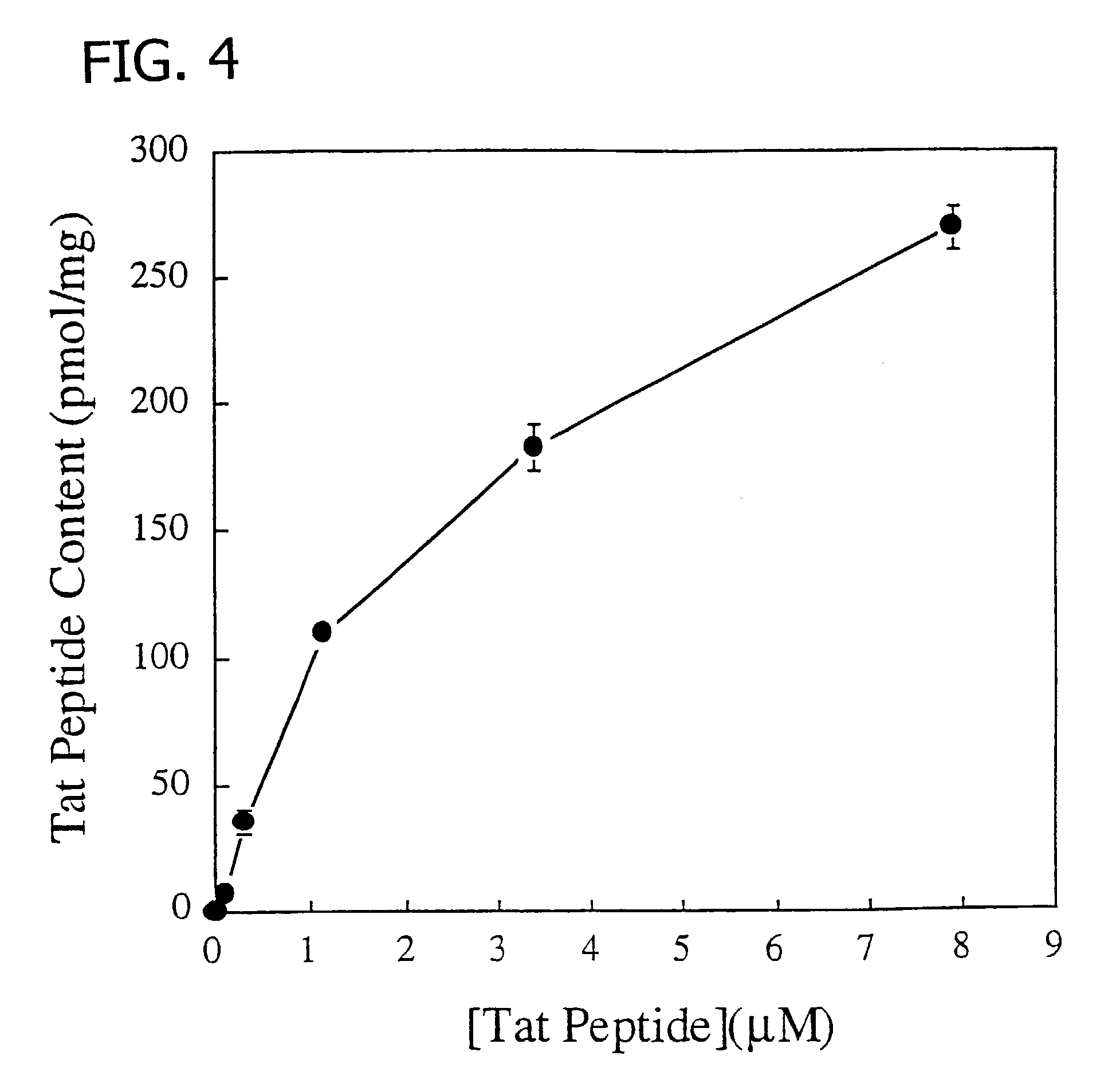Membrane-permeant peptide complexes for medical imaging, diagnostics, and pharmaceutical therapy
a technology of membrane-permeant peptides and complexes, applied in the field of medicine, can solve the problems of preventing the reporting preventing the use of peptide radiopharmaceuticals for intracellular targets, and preventing the accumulation of peptide metal chelates. to achieve the effect of increasing the accumulation of peptide metal chelates within cells
- Summary
- Abstract
- Description
- Claims
- Application Information
AI Technical Summary
Benefits of technology
Problems solved by technology
Method used
Image
Examples
example 1
Preparation of acetyI-GRKKRRQRRR-AHA-εKGC-amide trifluoroacetate
[0125]A Tat peptide (residues 48-57, GRKKRRQRRR (SEQ ID NO: 7)) conjugate was prepared by solid phase peptide synthesis using N-α-FMOC-protected amino acids and standard BOP / HOBt coupling chemistry (Merifield et al., Biochemistry 21:5020-5031, 1982; Houghten, Proc Natl Acad Sci USA 82:5131-5135, 1985; Lin, et al., Biochemistry 27:5640-5645, 1988), except for the ε-Lys residue, which used an N-α-tBOC, N-ε-FMOC-Lys residue to generate the desired peptide-based N3S chelating group for an incoming metal (Lister-James, et al., Q J Nucl Med 41:111-118, 1997). AHA represents aminohexanoic acid as an example of a non-functional linker between the Tat 48-57 residues and the chelating moiety. The peptide was amino acetylated, carboxy amidated, and deprotected by standard methods (Merifield et al., Biochemistry 21:5020-5031, 1982; Houghten, Proc Natl Acad Sci USA 82:5131-5135, 1985; Lin, et al., Biochemistry 27:5640-5645, 1988). T...
example 2
Preparation of Radiolabeled acetyl-GRKKRRQRRR-AHA-εKGC-amide(Tcv-99m) trifluoroacetate
[0126]The Tat peptide conjugate complex of Example 1 was labeled with Tc-99m by ligand exchange using Tc-99m-glucoheptonate as the ligand exchange reagent (Lister-James et al., J. Nucl. Med. 38:105-111, 1997). A commercially available stannous glucoheptonate radiopharmaceutical kit (Glucoscan, DuPont Pharma, Billerica, Mass.) was reconstituted with 1.0 ml of (Tc-99m)sodium pertechnetate (50 mCi) in isotonic saline obtained by eluting a commercial radionuclide Mo-99 / Tc-99m generator, and allowed to stand for 15 min at room temperature. In a small glass vial, Tat peptide conjugate (1 mg) was dissolved in 0.9% saline (1 ml). Then, (Tc-99m)glucoheptonate (250 μl) was added and the reaction allowed to proceed at room temperature for 15 min. Radiochemical yield (>95%) of the oxotechnetium complex (FIG. 2) and purity (≧90%) were determined by silica gel TLC using 15% TFA and radiometric detection (Bioscan...
example 3
Preparation of acetyl-GRKKRRQRRR-AHA-εKGC-amide-fluorescein-maleimide trifluoroacetate
[0127]The Tat peptide conjugate of Example 1 was labeled with fluorescein according to Vives et at. (J. Biol. Chem., 272:16010-16017, 1997). In a small glass vial, Tat peptide conjugate (1 mg) was dissolved in phosphate buffered saline (pH 7.4) and reacted with 1.2 eq of fluorescein maleimide dissolved in dimethylformamide for 2 hours in the dark at room temperature. The reaction was monitored by RP-HPLC at both 211 nm and 440 nm. Fluorescent peptides were purified by HPLC (purity >97%) using the above gradient conditions and lyophilized in the dark. The identity of the desired fluorescein labeled peptide was confirmed by electrospray mass spectrometry (m / z: 2211.0).
PUM
| Property | Measurement | Unit |
|---|---|---|
| energy | aaaaa | aaaaa |
| pH | aaaaa | aaaaa |
| temperature | aaaaa | aaaaa |
Abstract
Description
Claims
Application Information
 Login to View More
Login to View More - R&D
- Intellectual Property
- Life Sciences
- Materials
- Tech Scout
- Unparalleled Data Quality
- Higher Quality Content
- 60% Fewer Hallucinations
Browse by: Latest US Patents, China's latest patents, Technical Efficacy Thesaurus, Application Domain, Technology Topic, Popular Technical Reports.
© 2025 PatSnap. All rights reserved.Legal|Privacy policy|Modern Slavery Act Transparency Statement|Sitemap|About US| Contact US: help@patsnap.com



